Did you know, about 51% of businesses are adopting the SaaS model? 38% of these businesses work exclusively on a SaaS platform now. These stats are rather shocking and make you wonder just how big the world of SaaS is.
SaaS stands for Software-as-a-Service. It is a booming industry and one of the fastest-growing trends in the business tech world.
🤔 How Big is SaaS in 2023?
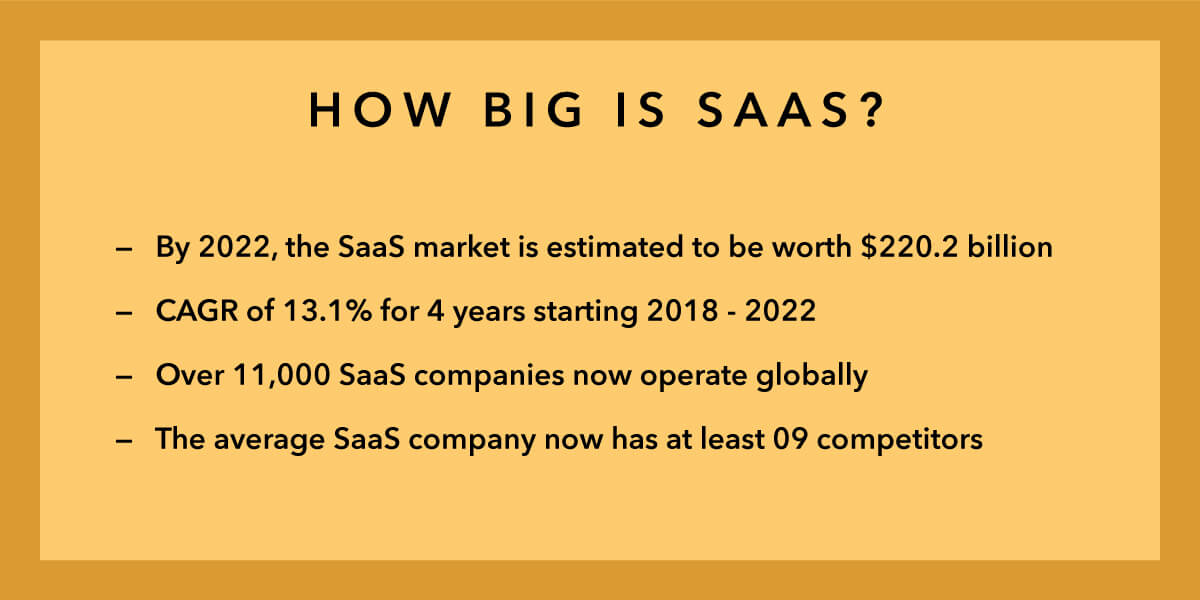
Businesses – small and large – are rapidly switching to the SaaS approach to save money, stay lean, and scale faster than ever before. To show you just how fast SaaS can help you scale, here is a recent example:
According to sources, Zoom, one of the most widely renowned SaaS video conferencing apps, said that its daily users spiked to 200 million in March, up from just 10 million in December.
Another resource reported that Slack, one of the most successful SaaS-based team chat software, had the highest conversion rate of 30% among freemium software products. It gained 8 million daily active users since its launch in 2014 and achieved a valuation of $7.1B just 4 years later.
Let’s Talk Numbers
There is a huge increase in the number of SaaS companies that have come to market over the last 10-15 years. The number of privately-owned SaaS companies has reached over 11,000 in just a few years.
By 2022, the SaaS market is estimated to be worth $220.2 billion, with a 13.1% CAGR within 4 years.
According to a report by Statista, the SaaS market value grows exponentially over the years. With the increasing demand for SaaS solutions, the competition among SaaS companies also accelerated.
Back in 2012, there were less than three competitors on average. By the end of 2017, at least 9 competitors were reported against an average SaaS company.
If you are someone who is looking to learn more about the SaaS market, you have to come to the right place. To set the right foot and establish your domain in the SaaS industry, you must know the basics.
We wrote this SaaS guide especially to walk you through every detail that you need to know.
Let’s get started.
SaaS in 2023 – Frequently Asked Questions
🤔 What is SaaS?

Software-as-a-Service is a software distribution model that powered the cloud. In SaaS, instead of the traditional way of distributing software with one-off payments, users get to access the application provided by the host via the Internet (usually through the browser).
With the SaaS model, access to software incurs an interval fee, usually charged per month or annum, depending on the software you are using. A wide range of software, from office software to communication applications, is available on the SaaS model.
SaaS offers a variety of advantages which include accessibility, compatibility, and lower costs to help you expand and develop your business.
To understand it better, let’s take the example of Trello, a popular productivity app by Atlassian. Users can simply access it via the web browser. Trello offers tiered paid and free plans, based on which access to Trello’s features are determined.
Before SaaS, we all remember the pain of buying the traditional software that required local installation on our devices and incurred hefty one-off fees. By using SaaS, usually, no installation is required and easy accessibility is guaranteed.
SaaS is the go-to software distribution strategy in 2023 for almost all kinds of businesses, from tech giants to small businesses.
SaaS operates on a subscription model where you pay as you go, and its popularity is growing rapidly across the world. According to statistics, the SaaS industry was worth $141 billion in 2019 and is expected to hit $157 billion in 2020.
As of now, around 80% of businesses around the world already use at least one SaaS application.
🤔 What is a SaaS Company?
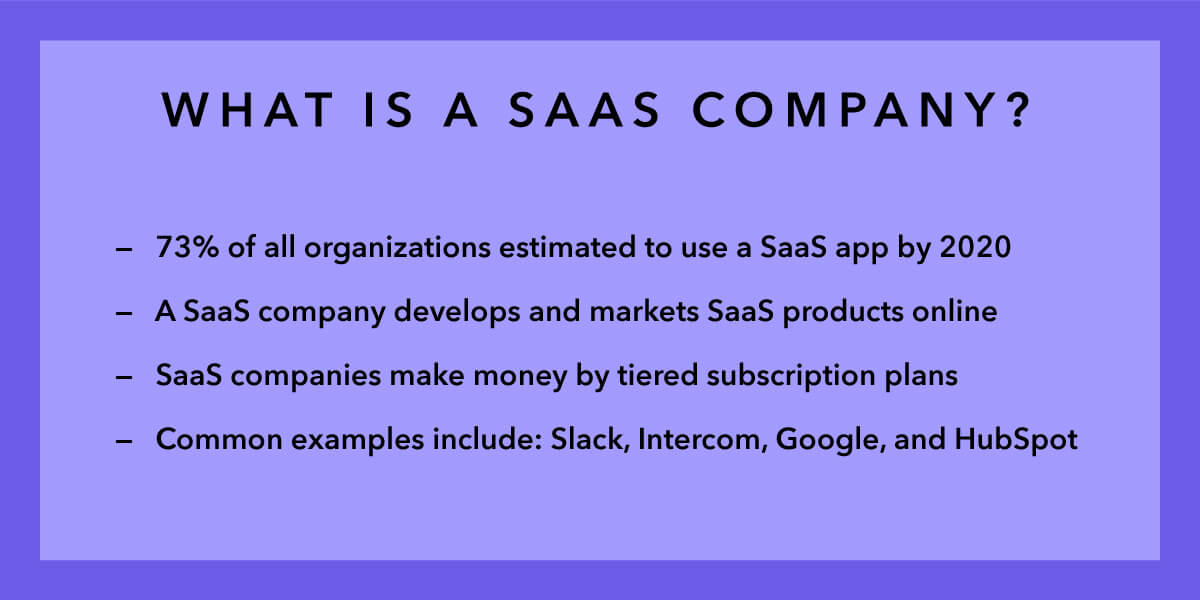
As per a recent report, 73% of organizations will be utilizing SaaS software for all their services by the end of 2020. Talking about the revenue in the SaaS industry, it is estimated to cross a total of $266.4 billion this year, according to a Gartner forecast.
The SaaS industry is flourishing with every passing second and SaaS services are becoming a trend. But here a question comes to mind that who provides these SaaS services?
These powerful SaaS services are offered by SaaS companies that are responsible for providing the software over the internet. To mention a few well-known successful SaaS companies, here is a list:
- Salesforce – Cloud-based CRM software
- Slack – Cloud-based team collaboration app
- MailChimp – Cloud-based email marketing platform
- DocuSign – Cloud-based document management app
- Dropbox – Cloud storage and collaboration service
These companies have dedicated servers to store the applications and their clients’ data. The cloud-based software is online, utilizes hosting usually provided by the SaaS company, and incurs a monthly/yearly subscription fee.
The subscription fees are also determined by taking into account a few other factors, such as:
- The total amount of data being stored by the client,
- Total number of users you wish to give access to this software,
- The level of access you require – customizations, features, APIs, etc.
- The level of technical support required by your business, etc.
SaaS companies control the access of various services provided to the users. Most of the SaaS companies allow their customers to customize their interfaces and select their services/features as required.
The Rise of SaaS and Google’s Dominance
Another famous example of a SaaS company would be Google. You can’t be reading this and not know about the tech giant. It will not be wrong to say that the company that started as a search engine, is now a tech giant, and Google made it all possible with SaaS.
Google transformed the world by introducing a wide range of SaaS services, such as:
- Gmail – email services for individuals and businesses
- Google Analytics – analytics for web apps and websites
- G Suite – collaboration platform for businesses
- YouTube – video creation and curation platform
From checking emails to cloud storage, broadcasts, cable TV, online advertising, and more – Google does it all. So much so, we wrote this piece using one of Google’s services – Google Docs.
🤔 What is a SaaS Application?
With the emergence of SaaS applications, more organizations are moving towards Saas services instead of traditional software. Why do you think that is?
SaaS applications are universally accessible from any platform allowing you to access your data and collaborate from just about anywhere with any device that is connected to the Internet.
Speed and ease of implementation are the prime aspects of a SaaS model. Software as service-based apps can be set up and integrated in just a few hours without going through all the hustle.
On the other hand, SaaS-based software is hosted by the vendors and thus they are responsible for maintaining, upgrading, and resolving any issues. This makes the SaaS model ideal for businesses and enterprises in terms of reliability.
SaaS apps have monthly or annual fees for subscribing to the service which can be easy to pay for people instead of large upfront costs.
And as your company grows, you can simply move to another tier of subscription to scale the service. Takes about a few clicks and it’s sorted.
SaaS vs. Traditional Software
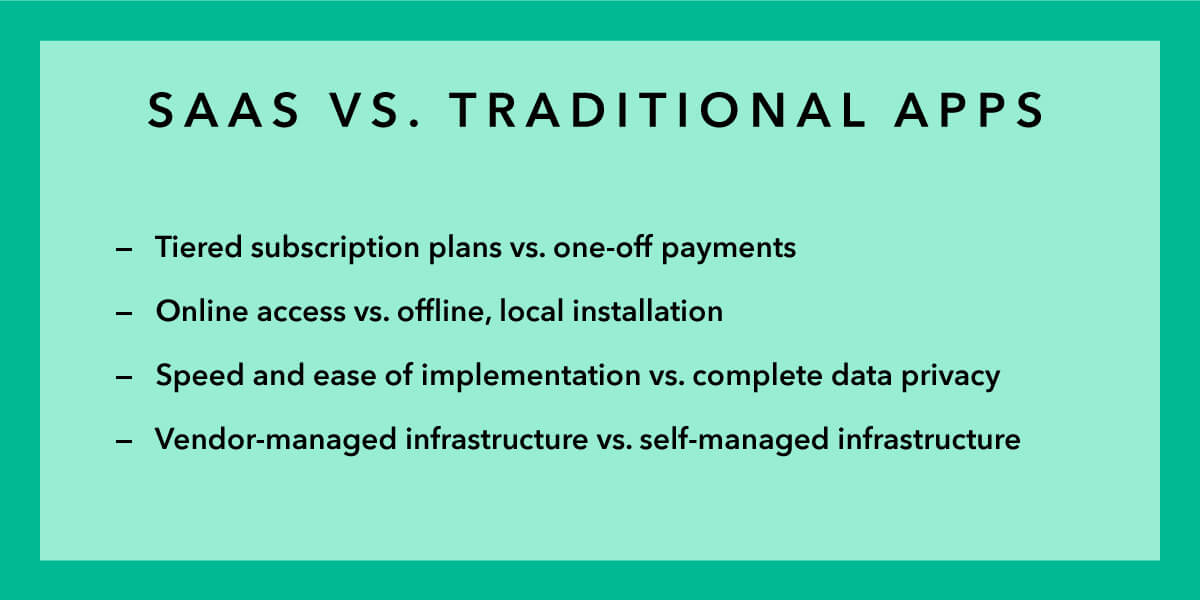
Traditional software is hefty, has large upfront costs, and requires local installation on computers/servers. Not to mention the required combined effort of the vendor and the IT team to get such software up and running.
Implementing traditional software in enterprises can take days and sometimes months as the process is time-consuming and complex. Also, with the release of an updated version of the software, users will have to pay again and go through the lengthy manual upgrade process.
When it comes to traditional software, costs also add up in the form of yearly maintenance, SLAs, certifications and training, and keeping a dedicated IT department to maintain the software.
Without a Service Level Agreement (SLA), if you run into a technical issue with the traditional software, you are mostly on your own. With each update to the software, hardware requirements also usually increase which further adds to the bill.
🤔 What is SaaS Marketing?
Marketing is a difficult task. Getting people to love and use your product requires a proper strategy. And when it comes to market a product that has no physical existence, the task gets even harder.
SaaS marketing is challenging and completely different from other forms of marketing.
SaaS marketing can be defined as marketing a SaaS application. It involves strategies to acquire new users and providing current users access to content that makes them return to your SaaS app in the long run.
Even though the basics of SaaS marketing are the same, but they can vary depending on the SaaS business model.
1. Conduct Market Research
Companies are required to do proper research to check their product’s demand in the market and plan their strategies accordingly. However, the real challenge in marketing is to identify your ideal customer base.
Once you recognize your ideal customer, make sure to understand their problems and market your product as a solution for those problems.
2. Gather Feedback
By getting customer feedback, you can tell other potential customers about how your product has helped certain businesses in becoming more productive. This is called storytelling and it is one of the most successful SaaS marketing concepts today.
3. Identify Channels & Avenues
Digital marketing is a key factor in gaining people’s attention by posting relevant ads, hosting webinars, and doing podcasts.
In SaaS marketing, the emphasis is based on keeping the customers happy so they don’t think about churning (canceling their subscription and moving elsewhere). It involves driving the users towards the product and turning them into long term customers.
To sell your product in the market, your sales and marketing team must be on the same page and have effective coordination for a good overall marketing strategy.
🤔 What is the Difference Between IaaS and SaaS?

Cloud is one of the hot topics in the tech industry. Its popularity and usage are growing continuously. Before the concept of Cloud computing, a cloud was only considered a fluff ball in the sky.
Now, it is known as the network of different servers that host, store, manage, and process data online.
Cloud comprises three models, SaaS, IaaS, and PaaS. Each one of them has its benefits and limitations. Let’s talk about them in detail here.
Firstly, we have Infrastructure-as-a-Service, commonly referred to as IaaS. It is a method of cloud computing that provides computer architecture and infrastructure over the internet.
IaaS empowers businesses to take control of the infrastructure layer – network, storage, and compute.
For example, suppose you rent a hosting server. Now you are free to set up the server to run any kind of OS you want, supporting any kind of application you want. The rented server is an IaaS resource, where you get computing resources and use them as per your needs.
Some of the examples of famous IaaS providers are Amazon Web Services, Digital Ocean, and Microsoft Azure.
In IaaS, the vendor manages the data storage, virtualization, servers, and networking while the users handle data & Middleware applications.
It allows you to drastically reduce costs while providing a secure and reliable infrastructure with system backups. You can host websites, test products, handle big data by implementing IaaS services.
IaaS should be used when you want full control over your infrastructure but don’t want to invest in physical hardware and IT infrastructure. While SaaS is preferred when we want to use pre-built solutions without the headache of managing the servers.
🤔 What is the Difference Between PaaS and SaaS?

Next is PaaS, which is an acronym for Platform-as-a-Service that delivers a framework for developers. This platform is used to build and customize their applications that sit on top of the PaaS layer.
PaaS can be used by developers to collaborate working on the same project without dealing with data serving, storage, and management. Some famous examples of PaaS platforms include Google’s App Engine and OpenShift.
PaaS makes the development, testing, and deployment of software quick and simple. Our traditional shared hosting websites come under the Platform-as-a-Service category.
Let’s take an example. Suppose you want to run a website powered by WordPress. All you need to do is to find a shared website hosting service that provides WordPress hosting. After finding the required hosting service, you can simply upload your website files, and get it up and running in no time.
You do not have to worry about hardware, installing PHP, managing servers, and installing operating systems. PaaS products are used as a framework to build new products while SaaS products are fully managed by vendors.
For companies looking for pre-built, cloud-based solutions, SaaS is the best choice. On the other hand, companies that want to build their solutions while cutting costs and saving time for the backend technologies use PaaS.
🤔 What Is a Good Churn Rate for SaaS?
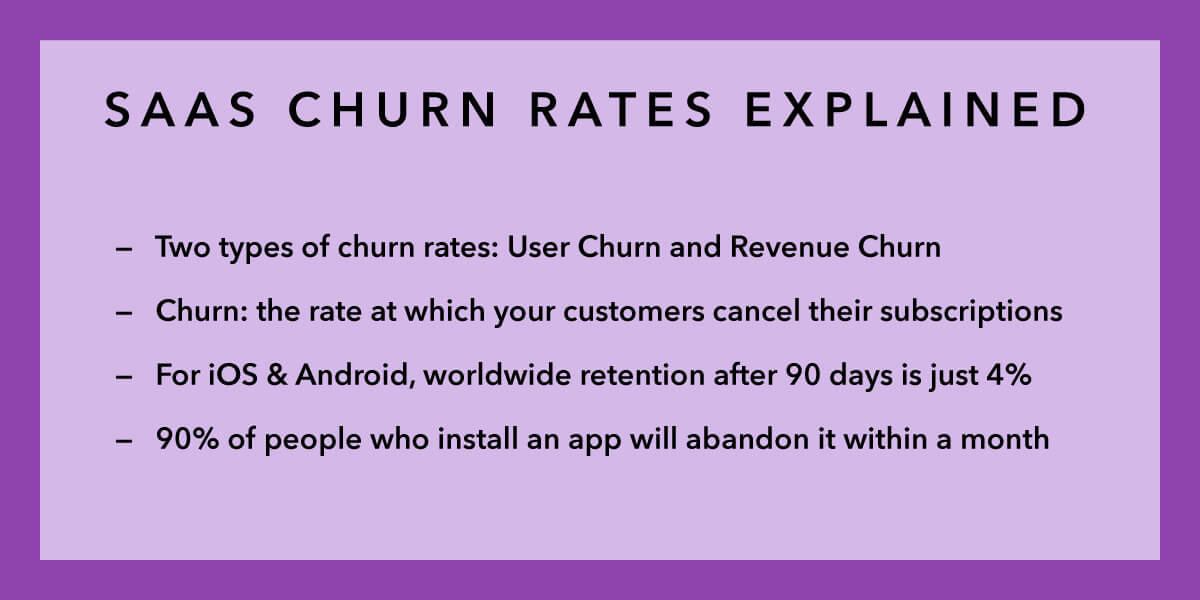
Churn rates are the ultimate metric to decide the success of any SaaS business. It is considered one of the most essential metrics that need to be handled carefully.
Churn represents the value of your product in the eyes of customers. The Churn Rate can be described as the rate at which your customers are canceling their subscriptions.
There are two different types of churn rates: Customer/User churn rate, and Revenue churn rate.
Customer Churn is the percentage of customers that you lose. So, if you have a 5% user churn rate that means each month 5% of your customer base is canceling.
Similarly, Revenue Churn is the percentage of revenue that you lose per month. Your revenue churn would be 5% if you lost $500 of your $10,000 monthly recurring revenue. In the total number of customers that you had, this might not be that bad.
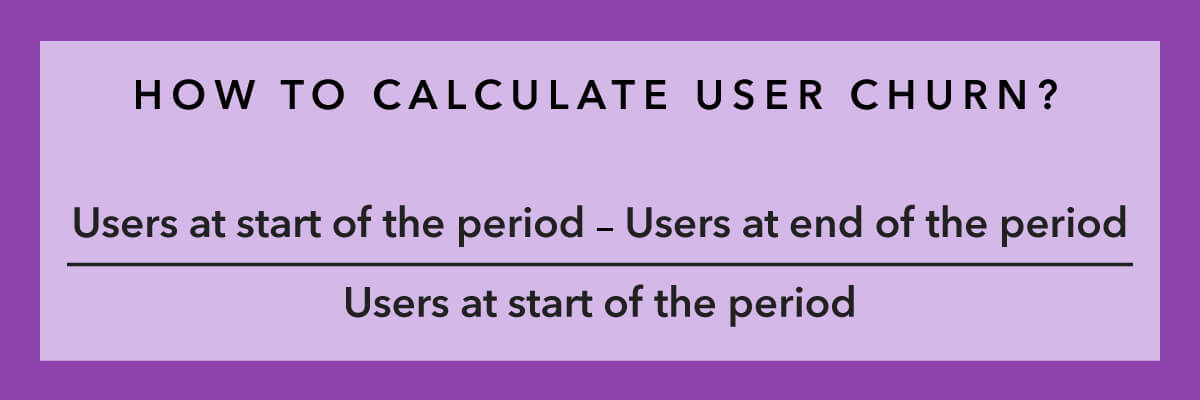

Churn Rate Example
Let’s take an example: suppose you have 100 customers and only one customer churned which is only 1% churn, right? Sounds good, but what if that one customer accounted for 20% of your revenue alone? In that case, you will have a horrible revenue churn.
Now, how can anyone decide as to what is a good churn rate?
According to Lincoln Murphy of Sixteen Ventures:
“An acceptable churn rate is in the 5 – 7% range annually, depending upon whether you measure customers or revenue.“
Keeping track of the churn rate is crucial for any SaaS business. After calculating your churn rate, you need to take measures against the cause behind it.
To take an example, let’s talk about Groove, a customer support platform, and live chat software. With a 4.5% churn rate in 2013, the company realized that its growth was unsustainable. Hence, they identified the red flags as to why the customers quit and made improvements.
These timely actions helped the company in reducing the churn rate as well as gaining even more customers.
Common SaaS Terminologies
🤔 What is ARR?

One must know the important metrics of SaaS before setting foot in the SaaS industry. So, here we will explain to you some significant metrics of SaaS to make your life easier.
Among the various other terminologies of SaaS, ARR is an important one. ARR stands for Annual Recurring Revenue, which is calculated based on yearly subscriptions.
It is often confused with ACV (Annual Contract Value) and MRR (Monthly Recurring Revenue). However, ARR is an annualized version of MRR.
This metric is considered the “mother of metrics” because of the powerful insights it provides to measure growth and churn rates for a SaaS company.
Most SaaS apps offer both monthly and yearly subscription plans to their customers. If customers of a company frequently opt for their annual plans, it is considered a big success which will result in a higher ARR.
By evaluating ARR, a company can easily forecast its revenue for the next year. This metric is more powerful and predictable as compared to MRR and represents the stability of a business.
🤩 Advantages of ARR
The primary advantages of ARR include a gain of insight regarding the contracts. Timely addressing the issues in contracts will help the company in gaining more customers and increasing revenue.
Identify which subscription models work best for your organization by evaluating ARR. In addition to these, companies can also predict a more precise churn rate based on ARR.
🤔 What is ACV?
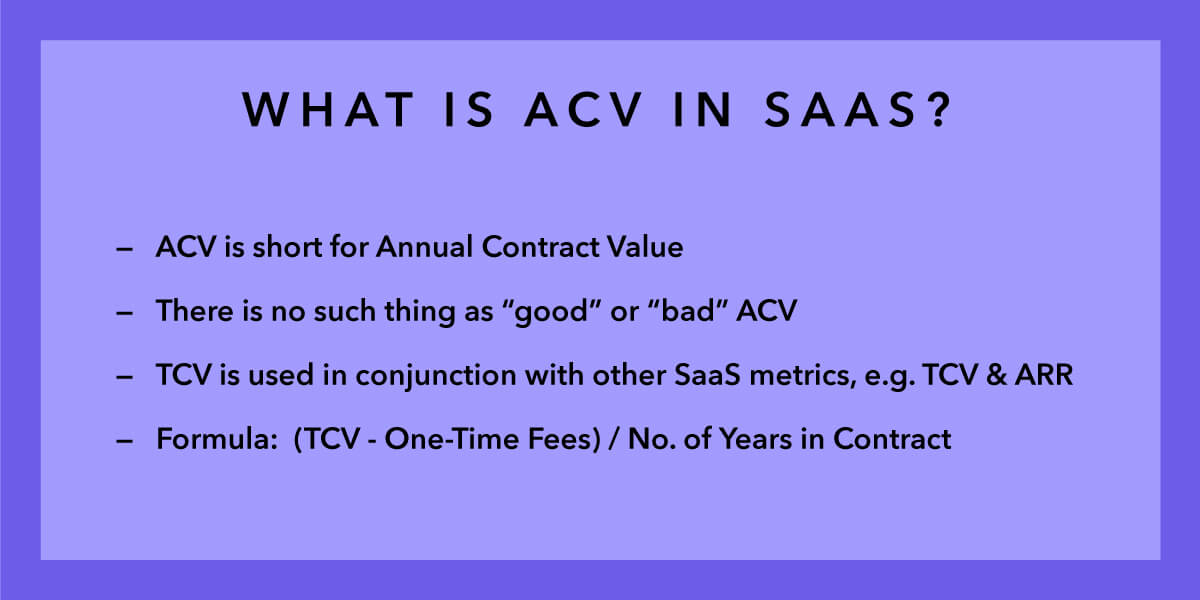
The majority of people tend to confuse ACV and ARR as they appear to be the same. However, both of them are important but entirely different metrics.
We have already explained what ARR is above. Let’s learn more about ACV now.
ACV stands for Annual Contract Value. It represents the average annualized revenue per customer contract.
ACV is a prime metric for any business model that relies on annual or multi-year subscriptions. It is not recommended to label an ACV as good or bad on its own, rather it’s best to evaluate it in conjunction with other metrics, such as CAC, TCV, etc.
Subscription-based SaaS business can be successful regardless of low or high ACV. The company’s growth is not dependent on the ACV. Some of the well-known companies like Slack, Spotify, and Dropbox generates a low ACV, yet they are still growing with break-neck speed.
When it comes to the benefits one can get from calculating the ACV, they are numerous. Even though it is a tricky metric, often hard to evaluate, it never fails to provide powerful insights to determine the marketing strategy and growth of your SaaS startup.
A precise ACV ensures consistency and accuracy to assess your revenue and growth.
Apart from this, ACV can help you in managing your sales and marketing strategy. By aiming your business on the right target, evaluated by using ACV will help in the expansion of your business growth.
Marketing teams will be able to focus on the right clients to generate more revenue. Even more so, having an idea about the calculated ACV also attract investors.
🤔 What is TCV?

Like ACV, TCV is another commonly used financial terminology in the SaaS world. Unfortunately, most people fail to understand this salient metric properly.
TCV stands for Total Contract Value, which summarizes the total value of the contract by considering its complete duration. It includes multi-year contracts as well as subscriptions with a definitive termination period.
Calculating TCV can make significant changes in your sales cycle and make it more cost-efficient.
The metric provides an accurate prediction of the company’s growth and revenue which in time leads to the development of effective sales and marketing strategies.
TCV is a powerful metric that is often neglected as it may not provide companies with flashier numbers based on accurate predictions initially.
However, by having a proper understanding of TCV, you can grow your SaaS business as fast as you can. To make you understand the significance of TCV, we are listing a few benefits below:
- TCV provides a precise prediction of revenue growth to assist in managing staff and optimizing the marketing budget. It plays an important role in redirecting financial resources and attracting investors.
- The metric can be used to identify profitable customers and concentrating sales strategies on them to generate more revenue.
- With TCV insights find out which package lengths work best for which cohorts and optimize sales based on this stat. Optimize your sales and increase average TCV by focusing on profitable contracts.
By utilizing the power of TCV you can steer your efforts in more efficient directions, predict accurate revenues, and grow your SaaS business effectively.
The Best SaaS Quotes in 2023
Business leaders all over the world are turning towards SaaS solutions to optimize the financial and operational impacts of their businesses.
We have provided you with all the basic information you need to understand the SaaS industry.
How about finding some motivation to keep yourself on track? We have gathered a collection of inspiring SaaS quotes from successful SaaS business leaders, guaranteed to get you pumped up. Give them a read below:
🤑 SaaS Quotes on Success
I know most people are looking for our “one top tip” or the magical “hack” that got us, customers, there isn’t just one thing. We grew email by email, Skype by Skype, webinar by webinar, and looking back I can’t distill it down to any one thing.
In the startup world, if your primary focus is on making money, you usually won’t make money.
Keep track of how many times you say ‘if’ when you explain how you’ll be successful.
Optimism, pessimism, f*ck that; we’re going to make it happen.
”
🤝🏼 SaaS Quotes on Team Building
Each time I have built a team, personal traits — not professional skills — have been what propelled the company forward.
Keep the team small. All doers, no talkers. Absolutely no middle managers.
You should recruit people that give you an unfair advantage. You should try to win the game before it starts.
Things don’t have to be in balance, to be in balance. You can work 16 hours a day and be in balance.
Buy second monitors for everyone, they will save at least 30 minutes a day, which is 100 hours a year.
🧐 SaaS Quotes on Data Analysis
It’s incredibly easy to interpret data in a way that suits your needs and justifies your conclusions.
Warning signs that your product sucks: “I’m really busy right now but I’ll start using your app soon.” author=
Chopping features is hard but a simple first step is just “Who’ll use this, and how often?”
Address bad news, develop methods to accelerate your personal recovery time, and then quickly take steps to right the ship.
Other SaaSy goodness on All That SaaS:
- 24 Amazing Journal Apps to Use in 2023: Android and iOS
- Top 20 SaaS Tips for Success: How to Sell SaaS in 2023
- 16 Awesome URL Shorteners You Should Use in 2023 (Free & Paid)
- 29 Powerful Resource Management & Planning Software in 2023
- 22 Best HR Management Software & Tools to Use in 2023
- 15 Best Gym Management Software Tools for Gym Owners in 2023
- 18 Best Time Tracking Software & Apps to Use in 2023
- 24 Best CRM Software for Better Customer Management in 2023
- 14 Powerful Screen Recording Software for iOS, Android, Mac, Windows & Linux
- 19 Email Clients for Maximum Email Productivity in 2023
- 10 Best Lead Generation Software to Use in 2023
- 25 Best Construction Management Software of 2023
- 10 Best Hospital Management Software (HMIS) of 2023
- 22 Best Mind Mapping Software of 2023
- 30 Best To-do List Apps of 2023: Manage Your Tasks Effectively
- 25 Best SaaS Blogs You Should Be Following in 2023
Great insights! One of the best articles I’ve found while searching for SaaS marketing.